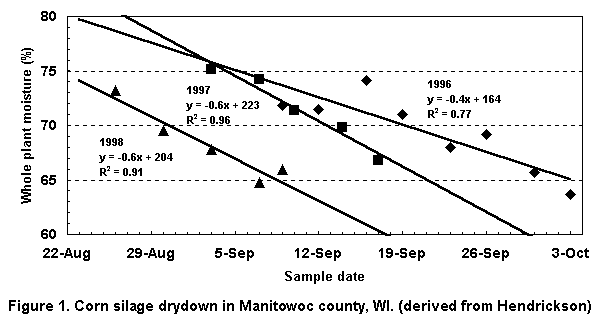Silage Drydown: How is it progressing?
August 26, 1999 6(23):140-141
Joe Lauer, Corn Agronomist
Great care has been taken in growing the 1999 corn silage crop beginning with hybrid
selection followed by planting, growing and managing the crop. All that work can
quickly be for nothing if the corn silage crop is not harvested correctly for the
storage structure. It is difficult to properly time harvest of a cornfield. The
forage must be at the proper moisture so that adequate fermentation and preservation
takes place. Once chopping begins, the storage structure must be filled quickly.
Optimum storage moistures for different storage structure are shown in Table 1.
Great variability exists between hybrids for rate of silage drydown. In addition,
the field environment will affect rate of drydown. Little correlation exists between
kernel milk stage and whole-plant moisture. For example, at 50% kernel milk, whole-plant
moistures have been observed to range from 50 to 74%. This range is unacceptable
for properly timing silage harvest.
There does exist a general relationship between kernel milk and whole-plant moisture.
We suggest using the kernel milk stage more as a "trigger" to sample fields
to determine where the cornfield is at for moisture (Table 1). If the "triggers"
are used, the field sampled will be too wet for the storage structure. But,
the plant moisture for the cornfield will be known and then a drydown rate of 0.5%
per day can be used to predict when that field will be ready to harvest. For example,
a cornfield, that will be used to fill a bunker silo (optimum moisture = 70 to 65%),
was found to be at 80% kernel milk and measured 73% whole-plant moisture. This field
will be ready for chopping in six days ( (73-70) / 0.5% ). Hybrid and environment
can still affect the rate of drydown. If there is further question about the moisture
status of a cornfield, then the field should be remeasured for moisture in the same
sites as the previous measurement.
The rate of drydown is relatively consistent once the kernel milkline begins to
move. The drydown rate for Manitowoc county during 1996 to 1998 has ranged from
0.4 to 0.6% per day (Figure 1). The harvest date to begin chopping has varied greatly.
For example, an upright concrete stave silo should be filled when whole-plant silage
moisture reaches 65%. The date to start filling this kind of structure has ranged
from September 9 to October 3 depending upon year.
The 1999 growing season has been similar to 1998 for Growing Degree Unit accumulation
and state average date where 50% of the corn acreage was planted. This year, since
July 12, we have been sampling four corn hybrids for yield and moisture at Arlington,
WI (Table 2). On August 15, whole-plant moisture average was 75%. In these fields,
we should be ready to begin filling bunker silos this week. Our next sample date
is August 25.
For the status of silage drydown rates in cornfields in Wisconsin check the website
at: http://cf.uwex.edu/ces/ag/silagedrydown/.
|
Table 1. Optimum whole-plant moisture range for various silage storage structures
and the kernel stage to begin sampling a corn field for timing harvest.
|
Silo structure
|
Recommended moisture
content for ensiling
|
Kernel milk
stage "trigger"
|
|
|
%
|
%
|
|
Horizontal bunker
|
70 to 65
|
80
|
|
Bag
|
70 to 60
|
80
|
|
Upright concrete stave
|
65 to 60
|
60
|
|
Upright oxygen limiting
|
60 to 50
|
40
|
"trigger": kernel milk stage to begin checking moisture in a field
Silage moisture decreases at an average rate of 0.5% per day during September
|
|
Table 2. Corn hybrid yield and moisture response to harvest date for four corn hybrids
grown during 1999 at Arlington, WI.
|
|
Harvest date
|
Growth stage
(Iowa system)
|
Dry matter
yield
|
Whole plant
moisture
|
|
|
|
T DM /A
|
%
|
|
July 12 July 19 July 28 August 6 August 15
|
V17 R1 R2 R3 R4
|
3.3 3.8 5.4 7.2 8.1
|
87 86 81 79 75
|
|
derived from Darby (unpublished)
|
